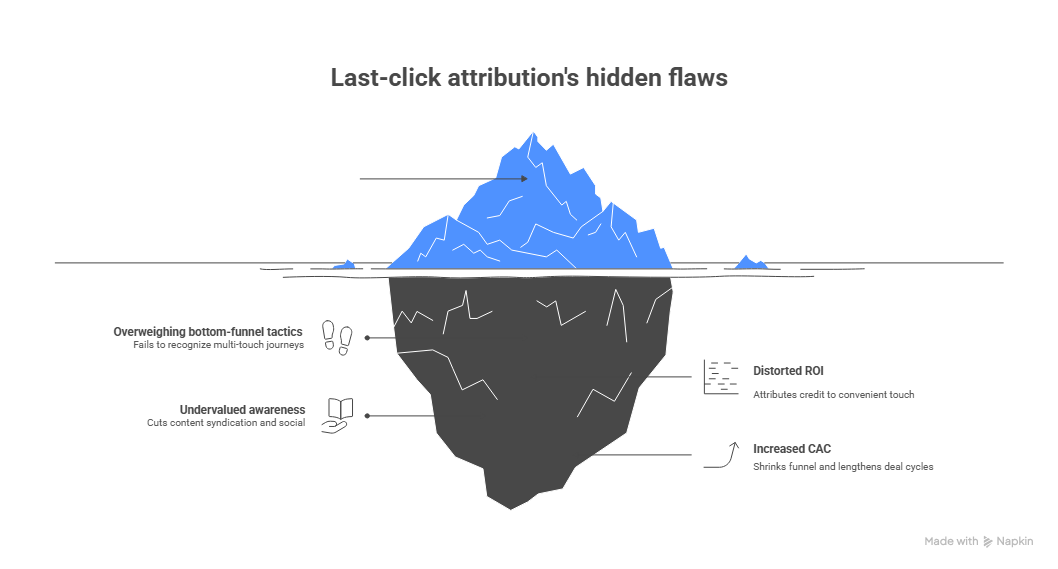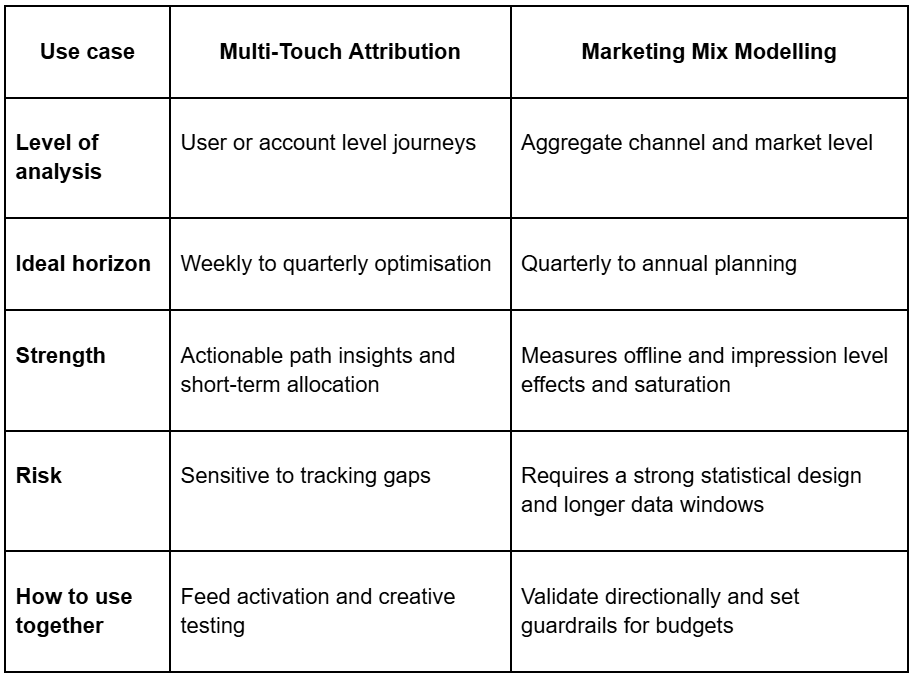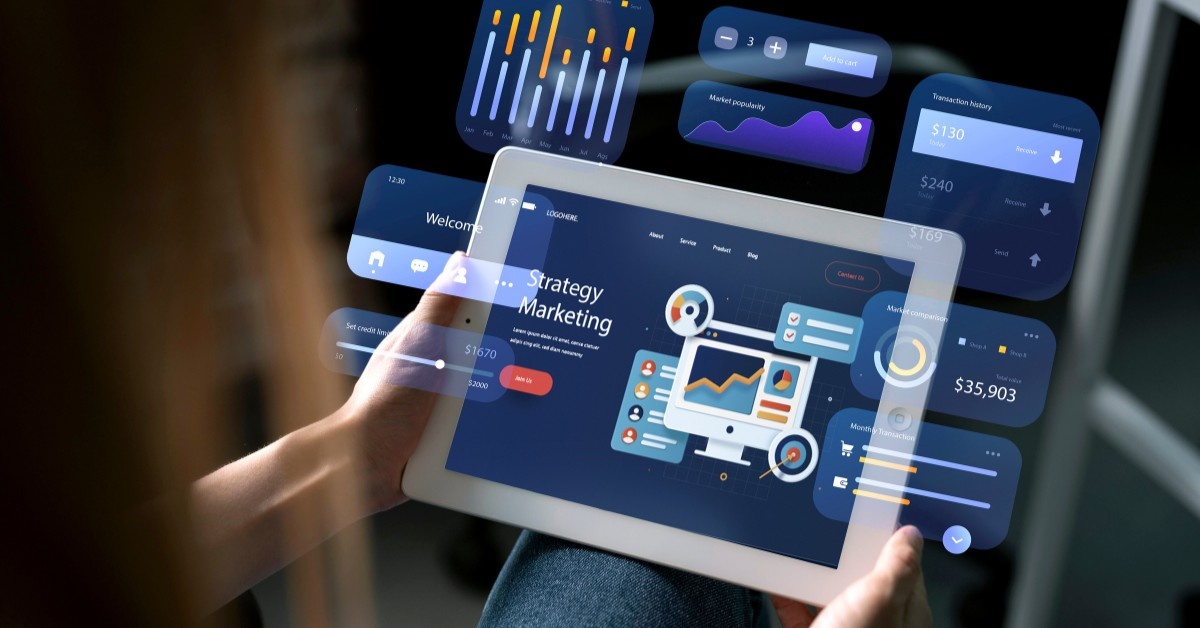The Death of Last-Click: How to Build Smarter Attribution Models with AI?
Attribution is back on the CMO priority list for two reasons -
- Journeys have grown longer and more fragmented across walled gardens, marketplaces, communities, and owned channels.
- AI now allows modelling that was impractical a few years ago, and it is shifting how budget and accountability work inside growth teams.
Last click attribution gives 100% credit to the final interaction before conversion. It dominated because it was easy to implement, aligned with how ad platforms reported performance, and aligned with search-heavy acquisition strategies. Many teams still use it as a baseline in GA4 and in ad platforms.
What has changed? Journeys are multi-touch and cross-device. Consent regimes and platform rules have constrained user-level tracking. Even with Chrome delaying its cookie deprecation, the privacy trajectory is clear.
Finally, AI models in analytics stacks now learn from raw event streams to assign credit with higher fidelity than rules-based models. This makes the last-click decision system untenable for budgeting and planning.
This FTA blog covers the problem with last-click, practical alternatives to follow, how AI enhances attribution, a build plan for CMOs, the pitfalls to avoid, the right success metrics, and an outlook on predictive and privacy-first attribution.
What exactly is wrong with last click attribution?
In multi-touch, cross-device journeys, the last-click model fails because it ignores earlier influence. It overweights bottom-funnel tactics such as branded search and retargeting while undervaluing awareness and mid-funnel programs. This biases the budget into tactics that close, not those that create demand.
It distorts ROI by attributing credit to the most convenient measurable touch. Branded search often captures credit that should be shared with channels that created demand upstream.
In GA4, data-driven attribution was introduced to reduce this skew, as the rule-based last-click model could not explain the lift from earlier touches.
Impact on awareness and mid-funnel. When attribution fails to capture the contribution of content syndication, social thought leadership, communities, webinars, and email nurture, CFOs cut them first.
This shrinks the top of the funnel, increases CAC over time, and lengthens deal cycles. Industry guidance consistently recommends multi-touch approaches for longer B2B cycles.

A B2B example to help you understand this - A prospect sees a LinkedIn ad, downloads a white paper, attends a webinar, then clicks a search ad to convert. In this case, last-click credits are only applied to the search ad.
Proper modelling shares credit across the sequence, revealing where to scale spend and where to tighten targeting. HubSpot and GA4 both provide model comparison views for this reason.

Here is a snapshot of the different attribution models data to understand the user’s time spent on a client website.
What are the different types of attribution models marketers can use today?
Single touch assigns all credit to a single event, such as the first or last touch. Multi-touch distributes credit across interactions. Multi-touch can be heuristic or algorithmic.
Heuristic examples include linear, time decay, and position-based. Algorithmic examples include data-driven and Markov chain models. GA4 defaults to data-driven where eligible. HubSpot exposes multiple models for comparison.
Pros and cons by model type -
- Linear model: The easiest story to socialise. Treats all touches equally, which can wash out the effect of critical accelerators.
- Time decay: rewards proximity to conversion. Penalises early demand creation more than is realistic for long cycles.
- Position-based: Splits most credit to first and last with a small mid share. Better than the previous click but still a rule.
- Data-driven: Uses your data to learn weights per touchpoint. Requires volume, clean data, and explainability.
Longer B2B cycles benefit from multi-touch models that can register nurture and consensus-building.
Heuristic models vs data-driven models
How is AI transforming attribution, and why does timing matter now?
AI contributes in four ways -
- Capability - Machine learning can evaluate thousands of journey paths and find patterns that human analysts cannot. Modern data-driven attribution in GA4 calculates the marginal contribution of each interaction per key event at the property level. Markov chain methods estimate removal effects by simulating journeys without a touchpoint.
- Hidden patterns - AI surfaces interactions that shorten cycles or improve lead quality, such as a webinar replay followed by a competitor comparison, or an email touch that always precedes high-intent demos. These are invisible in last click views.
- Online-to-offline - AI models stitched to CRM and POS data close the loop across channels like events, field sales, and partner referrals. Practitioners increasingly combine multi-touch attribution at the user level with marketing mix modelling at the aggregate level to model offline and impression-level effects.
- C-suite benefits - CMOs gain real-time optimisation, better cross-channel insights, and predictive accuracy for budget scenarios. Search Engine Land’s 2025 guide and MarTech’s overview reflect this shift from reporting to decisioning. The timing matters because orgs that delay will continue to lock budgets into biased last-click baselines.
How can CMOs build a smarter attribution model powered by AI?
Step 1. Map the end-to-end journey. Document stages and canonical touchpoints across media, web, product, sales, partner, and success. Include self-serve research behaviours from communities and review sites. Use this as the basis for event instrumentation and taxonomy.
Step 2. Audit the data pipeline. Ensure clean, unified tracking across web and app with consistent identities, consent capture, and CRM stitching. GA4 with BigQuery export is a practical foundation for event-level analysis and custom models.
Step 3. Choose a base model. Select a heuristic model as your baseline for stakeholder onboarding. Then run a data-driven model in parallel and compare allocation differences across a quarter. Use model comparison features where available.
Step 4. Select platforms that integrate CRM, analytics, and AI. Your stack should connect ad platforms, analytics, CDP or CRM, and a modelling layer. HubSpot and GA4 both support multi-touch reporting and can feed model outputs to activation.
Step 5. Train and validate with history. Use 12 to 24 months of event and revenue data if available. Evaluate models on out-of-time samples and assess stability when channels or budgets change. Markov or GA4 models can be validated through holdout campaigns and geo splits.
Step 6. Embed insights into decisions. Replace last click budget guardrails with model-informed allocation rules. For example, increase spend on touches that consistently shorten cycle time or improve win rate, not just those with the lowest cost per lead. Search Engine Land highlights moving from channel reporting to contribution analysis.
Step 7. Build governance for improvement and explainability. Establish a quarterly model review, data quality scorecards, and executive narratives that explain shifts in weightings. Keep a last click baseline for continuity, but manage to the smarter model.
Here is an example from a mid-sized B2B manufacturer to help you better understand this -
They discovered that event leads nurtured through two follow-up emails appeared in 40% of closed deals, but were rarely the last touch. After applying AI-based attribution, they found that this sequence significantly reduced the sales cycle. They shifted budget from generic search ads to events and email nurturing, lowering CAC and speeding up pipeline growth.
What challenges or pitfalls should CMOs expect?
- Fragmented data - Customer touchpoints live in disconnected systems. Fix this with unified IDs and CRM- analytics integration.
- Privacy restrictions - Regulations and platform limits reduce tracking. Focus on first-party data and modelled conversions.
- Model opacity - Leaders need clarity on why weights change. Use tools that show contribution paths, not black boxes.
- Change management - Teams must unlearn last-click thinking. Run models side-by-side for a quarter before shifting KPIs.
- Context over data worship - Numbers need context, such as pricing or seasonality. Combine MTA with MMM for accuracy.
- Talent and resources - AI-driven attribution requires skilled analysts. Start small with native tools before scaling.
How should success be measured once you move beyond last click?
- Focus on business outcomes - Track CAC, LTV, payback period, and revenue contribution by channel or buying group. Add conversion speed and win rate for sourced and influenced deals.
- Benchmark against last click - Run old and new models in parallel for a quarter. Compare CAC, allocation shifts, and velocity. Move to the AI-driven model once it delivers consistent revenue efficiency.
- Find true accelerators - Use path analysis to spot touchpoints that shorten cycles or lift lead quality (like webinar → pricing page visits). Double down on those interactions.
- Keep it dynamic - Refresh models as campaigns, creative, and audiences evolve. Maintain visibility with finance so attribution drives budget decisions, not just reporting.
MTA and MMM in one operating model

What does the future of attribution look like in the AI era?
Real-time attribution and dynamic budgets. With streaming data and model inference, budgets shift within guardrails based on contribution rather than just click-through. This is already visible in platform roadmaps and practitioner guidance that emphasises decision-making over reporting.
Even with Chrome keeping third-party cookies, regulators and platforms are moving to privacy-preserving APIs and aggregated measurement. Expect more modelled conversions, clean rooms, and consent-centric identity. Plan for it now.
Predictive attribution will become standard, with models estimating the expected contribution of future touches before spend happens. This is a natural extension of data-driven methods in GA4 and market practice in advanced teams.
Prepare by standardising event schemas, unifying identities, and hiring analysts who can explain models to finance in plain language. This is change management. Not a tooling exercise. MarTech and Search Engine Land both call out the organisational shift required.
From measuring clicks to measuring contribution. CMOs will judge channels by their role in creating revenue momentum. This aligns marketing with sales and finance and ends the culture of vanity metrics.
Building smarter attribution is about mindset, process, and data discipline
The last click is no longer a reliable basis for modern marketing decisions. It hides the value of demand creation and encourages underinvestment in what truly moves revenue.
CMOs should move toward AI-enabled attribution that learns from your data, connects online and offline, and supports real decisions on budget and focus. GA4 and HubSpot provide pragmatic on-ramps, and combining MTA with MMM covers both activation and planning.
Technology is the multiplier once foundations are in place. The brands that act now will build a growth engine that compounds. Those who wait will keep optimising the last mile while losing the market.
Bonus: An Executive FTA Toolkit
Quick comparison chart of attribution models
Use this as a quick reference when you are reviewing your monthly plans.
- Single touch models
- First touch. Measures sources that create demand. Good for top of funnel diagnostics.
- Last touch. Measures closers. Only useful as a baseline.
- First touch. Measures sources that create demand. Good for top of funnel diagnostics.
- Multi-touch heuristic
- Linear. Balanced view when you lack volume for advanced models.
- Time decay. Rewards sales assist touches late in the journey.
- Position-based. Gives proper weight to the opener and closer in long cycles.
- Linear. Balanced view when you lack volume for advanced models.
- Multi-touch algorithmic
- Data-driven. Learns weights from your data. Use when you have event-level data and volume.
- Markov chain. Useful for analysis of removal effects and scenario modelling.
- Data-driven. Learns weights from your data. Use when you have event-level data and volume.
References for model behavior and platform availability.
Here is a checklist for assessing if your organisation is ready for AI-driven attribution:
- Journey map documented with canonical touchpoints across media, web, sales, partner, and product
- Event schema standardised across web and app and exported to a warehouse or BigQuery
- Consent, identity, and CRM stitching strategy defined
- GA4 data-driven model enabled and model comparison practised for a quarter
- HubSpot multi-touch reports used in QBRs with finance participation
- Offline sources integrated sales, events, partners, and call tracking
- MMM partner or methodology in place for aggregate effects
- Quarterly model review and change log maintained
- Analysts trained to explain contribution and path insights in plain language
- Budget governance updated to act on contribution, not only the last click
How is AI transforming attribution, and why does timing matter now?
AI contributes in four ways -
- Capability - Machine learning can evaluate thousands of journey paths and find patterns that human analysts cannot. Modern data-driven attribution in GA4 calculates the marginal contribution of each interaction per key event at the property level. Markov chain methods estimate removal effects by simulating journeys without a touchpoint.
- Hidden patterns - AI surfaces interactions that shorten cycles or improve lead quality, such as a webinar replay followed by a competitor comparison, or an email touch that always precedes high-intent demos. These are invisible in last click views.
- Online-to-offline - AI models stitched to CRM and POS data close the loop across channels like events, field sales, and partner referrals. Practitioners increasingly combine multi-touch attribution at the user level with marketing mix modelling at the aggregate level to model offline and impression-level effects.
- C-suite benefits - CMOs gain real-time optimisation, better cross-channel insights, and predictive accuracy for budget scenarios. Search Engine Land’s 2025 guide and MarTech’s overview reflect this shift from reporting to decisioning. The timing matters because orgs that delay will continue to lock budgets into biased last-click baselines.
How can CMOs build a smarter attribution model powered by AI?
Step 1. Map the end-to-end journey. Document stages and canonical touchpoints across media, web, product, sales, partner, and success. Include self-serve research behaviours from communities and review sites. Use this as the basis for event instrumentation and taxonomy.
Step 2. Audit the data pipeline. Ensure clean, unified tracking across web and app with consistent identities, consent capture, and CRM stitching. GA4 with BigQuery export is a practical foundation for event-level analysis and custom models.
Step 3. Choose a base model. Select a heuristic model as your baseline for stakeholder onboarding. Then run a data-driven model in parallel and compare allocation differences across a quarter. Use model comparison features where available.
Step 4. Select platforms that integrate CRM, analytics, and AI. Your stack should connect ad platforms, analytics, CDP or CRM, and a modelling layer. HubSpot and GA4 both support multi-touch reporting and can feed model outputs to activation.
Step 5. Train and validate with history. Use 12 to 24 months of event and revenue data if available. Evaluate models on out-of-time samples and assess stability when channels or budgets change. Markov or GA4 models can be validated through holdout campaigns and geo splits.
Step 6. Embed insights into decisions. Replace last click budget guardrails with model-informed allocation rules. For example, increase spend on touches that consistently shorten cycle time or improve win rate, not just those with the lowest cost per lead. Search Engine Land highlights moving from channel reporting to contribution analysis.
Step 7. Build governance for improvement and explainability. Establish a quarterly model review, data quality scorecards, and executive narratives that explain shifts in weightings. Keep a last click baseline for continuity, but manage to the smarter model.
Here is an example from a mid-sized B2B manufacturer to help you better understand this -
They discovered that event leads nurtured through two follow-up emails appeared in 40% of closed deals, but were rarely the last touch. After applying AI-based attribution, they found that this sequence significantly reduced the sales cycle. They shifted budget from generic search ads to events and email nurturing, lowering CAC and speeding up pipeline growth.
What challenges or pitfalls should CMOs expect?
- Fragmented data - Customer touchpoints live in disconnected systems. Fix this with unified IDs and CRM- analytics integration.
- Privacy restrictions - Regulations and platform limits reduce tracking. Focus on first-party data and modelled conversions.
- Model opacity - Leaders need clarity on why weights change. Use tools that show contribution paths, not black boxes.
- Change management - Teams must unlearn last-click thinking. Run models side-by-side for a quarter before shifting KPIs.
- Context over data worship - Numbers need context, such as pricing or seasonality. Combine MTA with MMM for accuracy.
- Talent and resources - AI-driven attribution requires skilled analysts. Start small with native tools before scaling.
How should success be measured once you move beyond last click?
- Focus on business outcomes - Track CAC, LTV, payback period, and revenue contribution by channel or buying group. Add conversion speed and win rate for sourced and influenced deals.
- Benchmark against last click - Run old and new models in parallel for a quarter. Compare CAC, allocation shifts, and velocity. Move to the AI-driven model once it delivers consistent revenue efficiency.
- Find true accelerators - Use path analysis to spot touchpoints that shorten cycles or lift lead quality (like webinar → pricing page visits). Double down on those interactions.
- Keep it dynamic - Refresh models as campaigns, creative, and audiences evolve. Maintain visibility with finance so attribution drives budget decisions, not just reporting.
MTA and MMM in one operating model

What does the future of attribution look like in the AI era?
Real-time attribution and dynamic budgets. With streaming data and model inference, budgets shift within guardrails based on contribution rather than just click-through. This is already visible in platform roadmaps and practitioner guidance that emphasises decision-making over reporting.
Even with Chrome keeping third-party cookies, regulators and platforms are moving to privacy-preserving APIs and aggregated measurement. Expect more modelled conversions, clean rooms, and consent-centric identity. Plan for it now.
Predictive attribution will become standard, with models estimating the expected contribution of future touches before spend happens. This is a natural extension of data-driven methods in GA4 and market practice in advanced teams.
Prepare by standardising event schemas, unifying identities, and hiring analysts who can explain models to finance in plain language. This is change management. Not a tooling exercise. MarTech and Search Engine Land both call out the organisational shift required.
From measuring clicks to measuring contribution. CMOs will judge channels by their role in creating revenue momentum. This aligns marketing with sales and finance and ends the culture of vanity metrics.
Building smarter attribution is about mindset, process, and data discipline
The last click is no longer a reliable basis for modern marketing decisions. It hides the value of demand creation and encourages underinvestment in what truly moves revenue.
CMOs should move toward AI-enabled attribution that learns from your data, connects online and offline, and supports real decisions on budget and focus. GA4 and HubSpot provide pragmatic on-ramps, and combining MTA with MMM covers both activation and planning.
Technology is the multiplier once foundations are in place. The brands that act now will build a growth engine that compounds. Those who wait will keep optimising the last mile while losing the market.
Bonus: An Executive FTA Toolkit
Quick comparison chart of attribution models
Use this as a quick reference when you are reviewing your monthly plans.
- Single touch models
- First touch. Measures sources that create demand. Good for top of funnel diagnostics.
- Last touch. Measures closers. Only useful as a baseline.
- First touch. Measures sources that create demand. Good for top of funnel diagnostics.
- Multi-touch heuristic
- Linear. Balanced view when you lack volume for advanced models.
- Time decay. Rewards sales assist touches late in the journey.
- Position-based. Gives proper weight to the opener and closer in long cycles.
- Linear. Balanced view when you lack volume for advanced models.
- Multi-touch algorithmic
- Data-driven. Learns weights from your data. Use when you have event-level data and volume.
- Markov chain. Useful for analysis of removal effects and scenario modelling.
- Data-driven. Learns weights from your data. Use when you have event-level data and volume.
References for model behavior and platform availability.
Here is a checklist for assessing if your organisation is ready for AI-driven attribution:
- Journey map documented with canonical touchpoints across media, web, sales, partner, and product
- Event schema standardised across web and app and exported to a warehouse or BigQuery
- Consent, identity, and CRM stitching strategy defined
- GA4 data-driven model enabled and model comparison practised for a quarter
- HubSpot multi-touch reports used in QBRs with finance participation
- Offline sources integrated sales, events, partners, and call tracking
- MMM partner or methodology in place for aggregate effects
- Quarterly model review and change log maintained
- Analysts trained to explain contribution and path insights in plain language
- Budget governance updated to act on contribution, not only the last click
Do you want more traffic?

How to Scale Personalisation in ABM Without Losing Focus?
.png)
Why Small Tasks Are the Next Big Revolution in Business Efficiency?







.jpeg)



